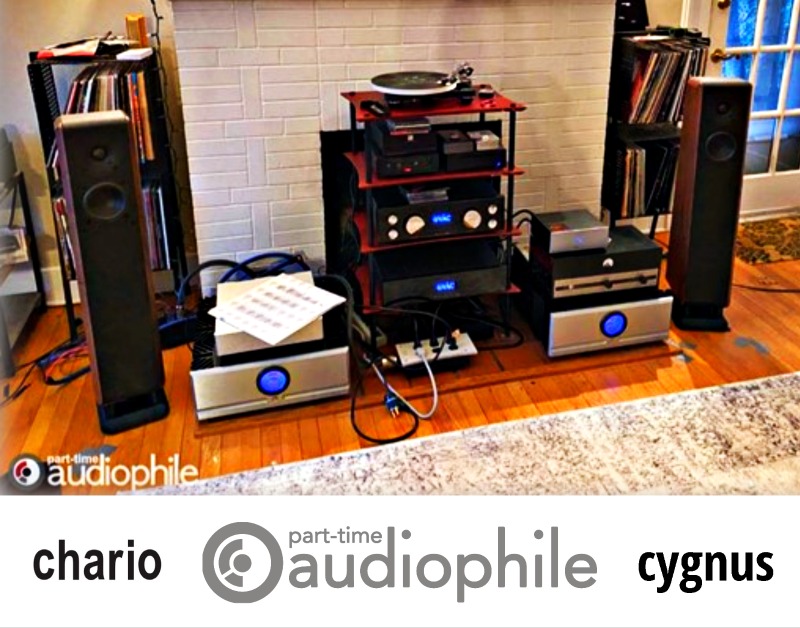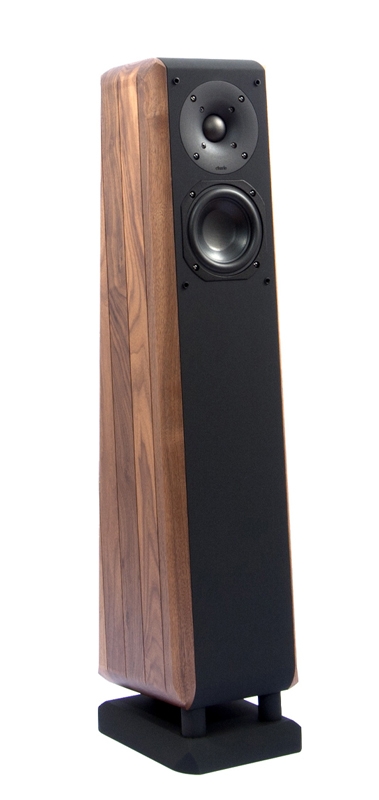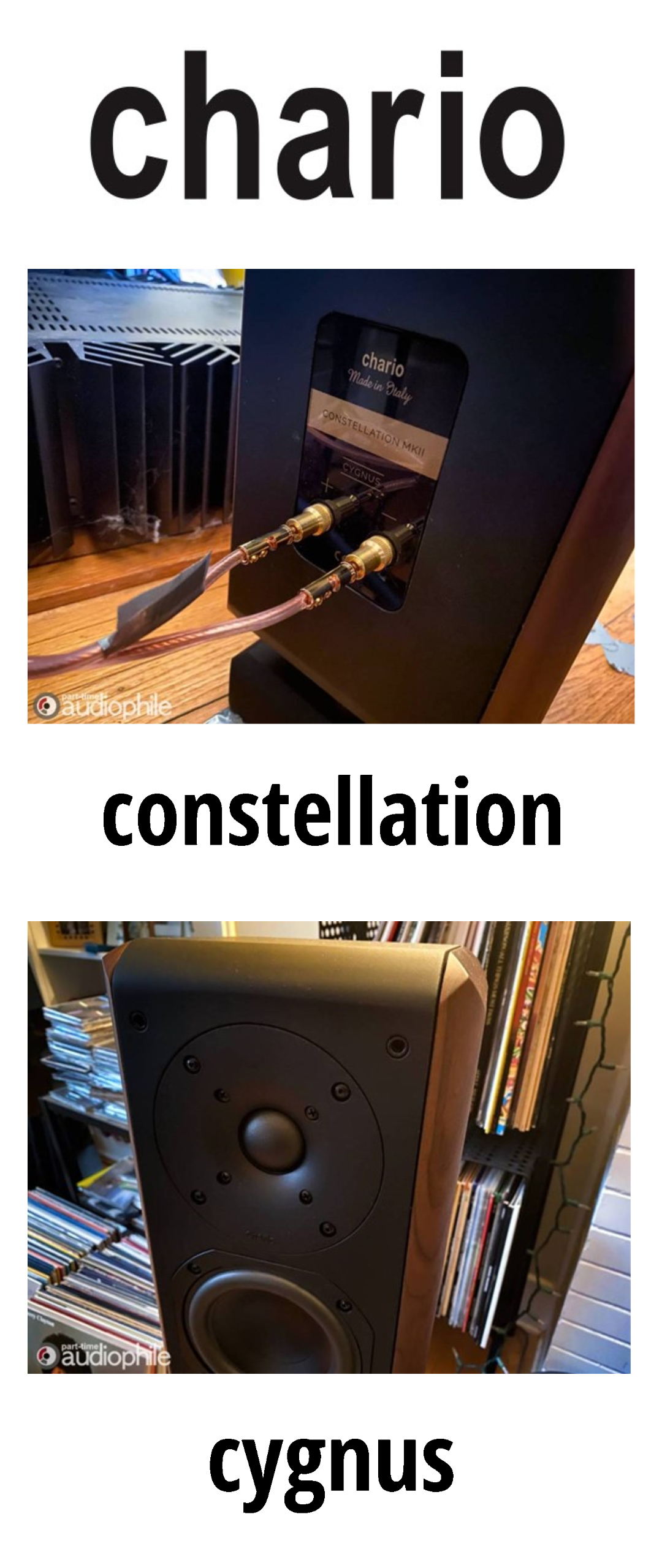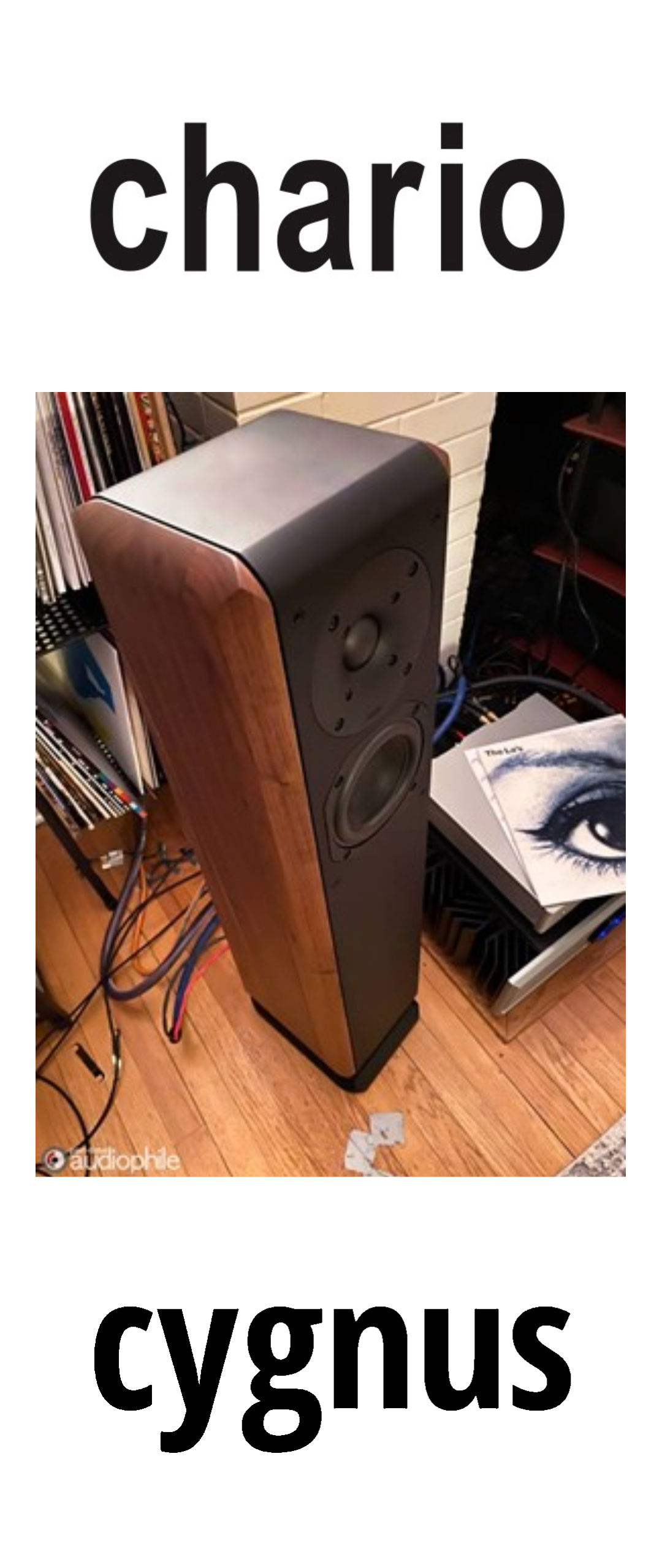Chario Cygnus Speaker Review
Buyers Guide 2022
Chario Constellation Cygnus Speaker Review
Review by Dave McNair, PartTimeAudiophile.com
Hi-Fi reviewers like reviewing products that sound good to them. I’m no exception. If I can’t hear a component before actually getting it, I’m always a bit leery. So it was a welcome and pleasant surprise when I fired up a pair of Chario Constellation Cygnus speakers in my listening room. After the hit parade of excellent loudspeakers I’ve recently had the pleasure of reviewing, it was a relief to find out that the relatively unknown (in the US) and modestly priced Cygnus ($3,700/pair) is no exception.


Ciao mio adorabile amico
The Cygnus is a mid-level offering in Chario’s entry-level Constellation line of speakers. The gente at Chario have been using fine Italian craftsmanship to make a LOT of different speaker models, and they’ve been doing so since 1975. There are four separate lines including Academy S, Aviator, Constellation II, and a limited edition Belong series. Within the Constellation line alone there are four different models named Lynx, Delphinus, Cygnus, and Pegasus. Must be some frequent espresso breaks happening at the Chario factory to get all those speakers ready to ship.
The Chario Constellation Cygnus is a three-way comprised of a 1.5” soft dome tweeter with a waveguide-style, flared surround that Chario calls their T38 (38 mm tweeter, get it?). A 5” midrange driver and a down-firing 5” woofer complete the picture. Crossover points are 1500 Hz and 170 Hz. Sensitivity is listed as 87db with a rated impedance of 4 ohms. At 37.5” inches high, it’s not short but the front baffle width of a little less than 8” and an overall depth of 10.5” was not imposing in my listening room. The hardwood side panels give the speaker a decidedly craftsman-like feel.
Chario Cygnus Speaker Review Continued
O technica mio
The following was kindly provided by Jon Baker of Monarch Systems Ltd., the Chario U.S. distributor:
Chario was founded in 1975 by two engineers–CHArlie Vicenzetto and MaRIO Murace–hence the name. Both were scientists at the University of Milan being just as interested in how humans hear as they were in how loudspeakers work. The theoretical premise was that if you build a speaker that is optimized for how test equipment measures, you may have been designing for the wrong audience. Likewise, tailoring a speaker for the human ear without technical knowledge regarding loudspeaker mechanics and acoustics prevents you from building an accurate, quality loudspeaker that does what you want it to do.
At the University of Milan, they pioneered research into the shape of the human head and torso and how that affects the way sound is captured by our ears. According to Charlie and Mario, humans aren’t receptive to phase distortion issues between 800-1,500 Hz. The shape of the human ear, head, chest, and shoulders are what defines this range. Loudspeaker crossovers create phase distortions at the crossover frequency, and nearly all loudspeakers cross over from the tweeter to the midrange driver above these frequencies which is where humans are extremely sensitive. So, Chario developed the idea of a tweeter that accurately went below this range and negated the need for a midrange crossover and driver altogether. The Chario loudspeakers in the Aviator series (their second range from the top) all have a tweeter that can—and does—play cleanly down to approximately 1,200 Hz. In the case of the Academy series, the tweeter performs down to 1,000 Hz. This is an insanely low frequency for a tweeter. Chario designed their tweeters to be able to play well below the range we’re sensitive to avoid the problem entirely.
This insanely broad tweeter range has another benefit: high and mid frequencies have a narrow dispersion pattern and tend to beam or be directed at the listener by aiming the tweeter. Broadening the range of the tweeter results in less “beaming,” and widens the dispersion of the high and mid frequencies, allowing the speaker to present a very broad sound field. Finally, low frequencies have a wide dispersion field, so mounting the woofer as far away as possible from the assumed first reflection point—the floor—eliminates reflective distortions where the reflected sound arrives at the listener’s ear later in time than the direct sound. Since tweeters have narrower dispersion, they should be placed at ear height. Since woofers have wider dispersion, they should be mounted further away from the floor. Thus, the Chario speakers have the woofer mounted high in the cabinet and away from the floor. This puts the woofer above the floor’s first reflection surface and reduces the comb filtering distortion that comes with it, while at the same time allowing the tweeter to be placed at ear-height for proper imaging focus.


Cygnus Set Up
Jon also passed on a setup procedure for finding how far away from the wall the Chario Constellation Cygnus sound best. This involved using a track off Duets by Rob Wasserman named “The Ballad Of The Runaway Horse,” beautifully sung by Jennifer Warnes. Condensing his more detailed text goes something like this:
Starting close to the listening room front wall and with one speaker turned sideways aiming away from the center, listen for just the two main upright bass notes in the chord sequence and move the forward-facing speaker out until the notes seem balanced. Also pay attention to the vocal sounding shouty or not, as the distance from the front wall is further changed. Turn the other speaker front-facing and repeat the procedure.
I found this to be a remarkably effective method. Subsequently, I made only very slight distance adjustments. Who knew? This placement fine-tuning yielded a closer-to-the-front-wall than usual position, which is no surprise considering those cute little 5” bass and mid drivers need all the wall reinforcement help they can use. What WAS surprising was just how little the imaging suffered and just how much bass satisfaction was achieved. I did find imaging to improve when I pulled them farther into my room. Some listeners may elect to forgo bass extension to have a very expansive and pinpoint stereo spread but I got plenty of that where I liked the low-end response best. C’mon, if you had told me I’d get satisfying bass out of a slender little floor stander with a 5” bass driver in MY room, I’d laugh. When I played some favorite tunes I was not laughing. But I WAS smiling.
Something else happened as I spent time with the Chario Constellation Cygnus. I stopped listening for flaws and simply grooved to the tunes. This doesn’t happen for me very often. Chalk it up to low expectations for this attractive yet modestly priced pair of speakers. But more importantly, I think it had more to do with a compelling yet hard to quantify mojo that these little dudes have.
I’ll admit it might be a little unrealistic to evaluate an entry-level pair of speakers in a system that consisted of a Rega P10 with a Charisma Signature One cartridge, VAC Master Preamplifier, Pass Labs XA-60.8 monoblocks, Innuos Zen Mini fed by Qobuz via Roon into the most excellent Denafrips Pontus DAC, various Furutech power cords and filtered GTX-D receptacles, hooked up with Cardas Clear cables, but that’s exactly what I did.
I pared things down a bit later by using the Zen Mini’s built-in DAC feeding my Audio Hungary Qualiton APX-200 mkII into the aux input with front panel volume control, to get a feel for a somewhat more realistic line up of componentry, price-wise. This last gear combo, sounded great feeding the Chario Constellation Cygnus. Okay, not as good as the full monty, but immensely enjoyable for about $60K less in cost.
Review by Dave Mcnair continued:
Listening
After firing up my Rancilio Miss Silvia espresso machine, I made my fav Counter Culture–Big Trouble–and Oatley’s oat milk latte before playing some cuts off the Mobile Fidelity half-speed master of James Taylor’s JT. It was extremely satisfying. The record was good, too.
Lee Sklar’s bass parts were phatt under James’ smooth as ever vocals. Drums were clear and punchy. Electric and acoustic guitar tone–check. What the heck is going on here? Is there another driver hidden in the back of these cabinets? Nope.
I might have smirked when I pulled out the latest album from the modern rock/hip hop group MISSIO. Their latest Can You Feel The Sun is one of my favs from this year. (Disclaimer: I mastered it so I’m a little biased.)
I was NOT smirking when the brilliant production and mix–being a dynamic mix of multi-colored synths, deep bass, and beats–suddenly jumped into my listening room. No, the low end didn’t go as low as what’s on the record and the Chario Constellation Cygnus don’t take to cranking at rock concert levels, but the essence of the music was in full force. I have a feeling the tweeter being crossed over at 1500 Hz is called on to do a lot of work, so some amount of tweeter diaphragm breakup (more than the mid and down-firing woofer) would explain what I hear when I unleashed the Kraken. Vocals took on a not-so-subtle edge when approaching Nominal Zeppelin Level.
As time went on, I realized that I seldom got the itch to lean on the volume. This wasn’t solely based on the speaker’s objection to producing dance club levels in my room, but rather that I found the Chario Constellation Cygnus to be remarkably satisfying at low to moderate volume levels.
When I was listening analytically it was obvious that the high-frequency response lends the Chario Constellation Cygnus a heightened sense of detail. It’s bright, but a good kind of bright. My ears tell me things around 8-10K are tipped up quite a bit, although in a way that wasn’t off-putting. Think loudness button on an old receiver minus the bass boost or the bright, tangy taste of a Marinara sauce made from garden fresh tomatoes. Mmmmmm.
How a bright-ish speaker with a 5” woofer didn’t sound thin or lean is a total mystery to me. Was it related to some timing/damping/dispersion characteristics? Maybe it’s because the Chario Constellation Cygnus gets the midrange right. The mids didn’t have any obvious colorations or any bumps and holes in the response, never sounding boxy nor scooped. The Cygnus passed the critical vocal test with flying colors.
I’m sure the midrange isn’t all THAT flat, but I came to realize how skillfully the Chario engineers imbued this entry-level performer with some unique personality that I found mesmerizing.
I cycled through more of my test favorites like Beck’s Sea Change, Donald Fagen’s Morph The Cat, Radiohead’s In Rainbows, Kevin Gilbert’s Thud, and Suzanne Vega’s Nine Objects Of Desire, to name a few. Once I had checked off all the basic performance-oriented investigative boxes, I had multiple listening sessions devoted to blind pulls or at least records I don’t normally use for component evaluation. I also had several listening sessions using only tunes streamed off Qobuz. While quite satisfying, I remain an avowed analog fan for its more complex harmonic texture, among other things. And DACs are harder to roll your stash on. Just sayin’.
Elton John’s Honky Chateau is a prime example of what makes certain ’70s era British recording consoles so sought after. Recorded on a Rupert Neve “desk” at a residential studio in the French countryside, then mixed in London on a Trident A-Range console, this record (and the other Elton albums during this fruitful period) has a very identifiable quality, mostly in the high frequencies. Boosting the top end on those now-legendary 10 series Neve mic pre/eq modules, and then again on the equally famed but even more rare eq in the A-Range, gives a unique sounding presence and immediacy that recording engineers die for to this day. The Chario Constellation Cygnus added its own extra sheen without sounding edgy or brittle. In fact, the treble sheen from that Chario T38 tweeter had a lusciously soft style of presence reminiscent of those classic discrete solid-state, transformer-coupled Neve and Trident equalizers.
I hadn’t played Keith Jarrett’s Death And The Flower in ages. The title cut covers all of side one, coming in at 22:45, and is quite the beguiling journey both musically and sonically. And that lineup of Jarrett, Dewey Redman, Charlie Haden, Paul Motian, and Guilherme Franco is not too shabby, either. Although this recording is sonically much darker than Elton, the Chario Constellation Cygnus almost synthesized a beautiful, airy presence on this 1975 recording. My copy is the quad version, which I had never noticed until now!
Streaming the 24bit 192K version (just cuz I can) of Richard Thompson’s Rumor And Sigh had a lovely, cracking effervescence to the sound. Powerful yet delicate which perfectly compliments this album.
Dexter Gordon’s One Flight Up, recorded in Paris after Dexter flew the coup to Scandanavia, sounded terrific. Art Taylor, Kenny Drew, and Niels-Henning Orsted joined in on this 1964 session, and Taylor’s drums are a lot hotter in the mix than most other typical jazz recordings of this era. Dexter’s tenor consequently felt a little low on some tunes but it was cool to hear loud drums swingin’ on a vintage bebop album. Donald Byrd’s trumpet on “Coppin’ The Haven” sounded amazing–round and warm, with lots of presence, but never strident.
One evening I went on a Bach piano recordings deep dive, made so easy by having Qobuz at my fingertips. Glenn Gould’s The Well -Tempered Clavier rocked my world. As I melted into the music I didn’t give much thought to the performance of the Chario Constellation Cygnus. This was all about worshiping at the altar of two musical geniuses.

Further Thoughts
I wasn’t the only one that reacted to the sonic charm of the Chario Constellation Cygnus. My partner Linda remarked several times about what she liked about the sound. Without my prompting, she described a cohesiveness and holistic quality to the sound using non-audiophile terms. At one point she asked me “How much are these? I might want a pair for my house!”
Any loudspeaker designer must deal with engineering compromises. Anyone that has designed speaker systems will tell you it might be MORE difficult (although uniquely rewarding) to figure out how to deal with the inherent compromises of an affordable loudspeaker design – while arriving at a musically satisfying result. I don’t know how much fun the engineers at Chario had cheffin’ up these slim Cygnus towers but I certainly had fun listening to them. Several times I wondered what the higher-end Chario speakers sound like. Would they have the magic of the modest yet mighty Cygnus?
Written by: Dave McNair
